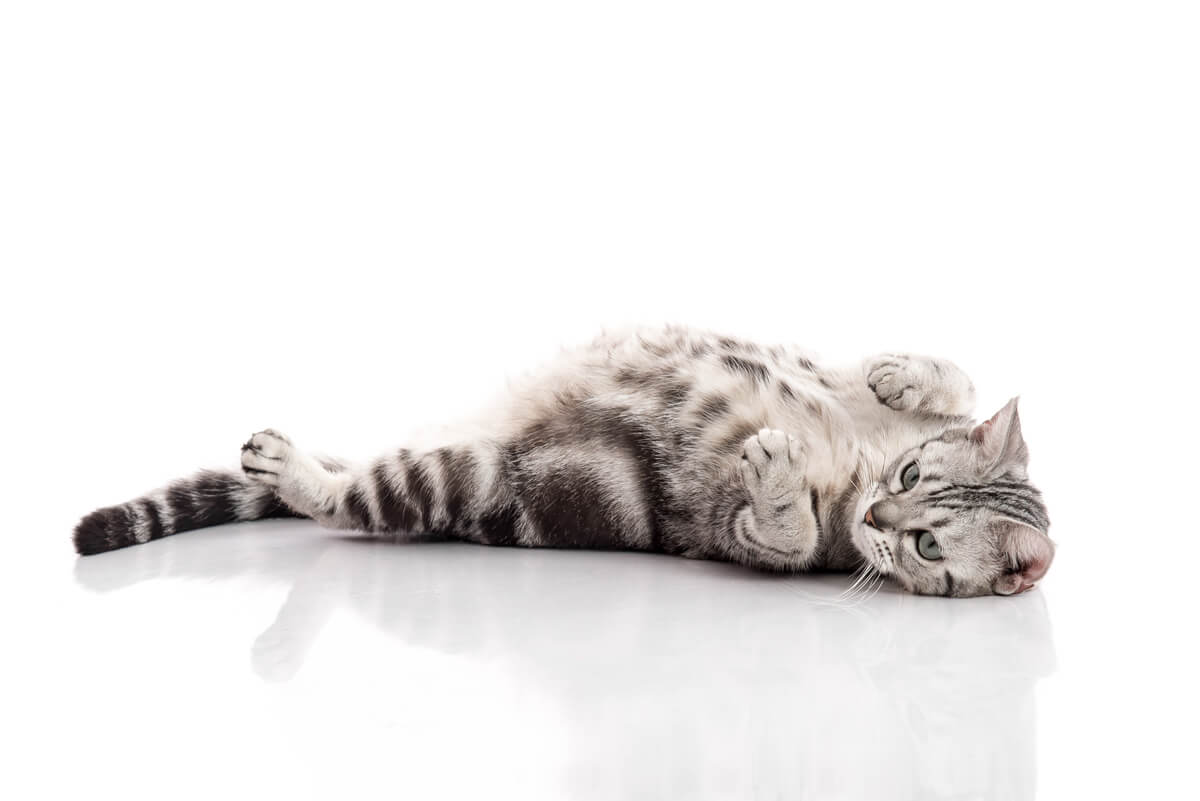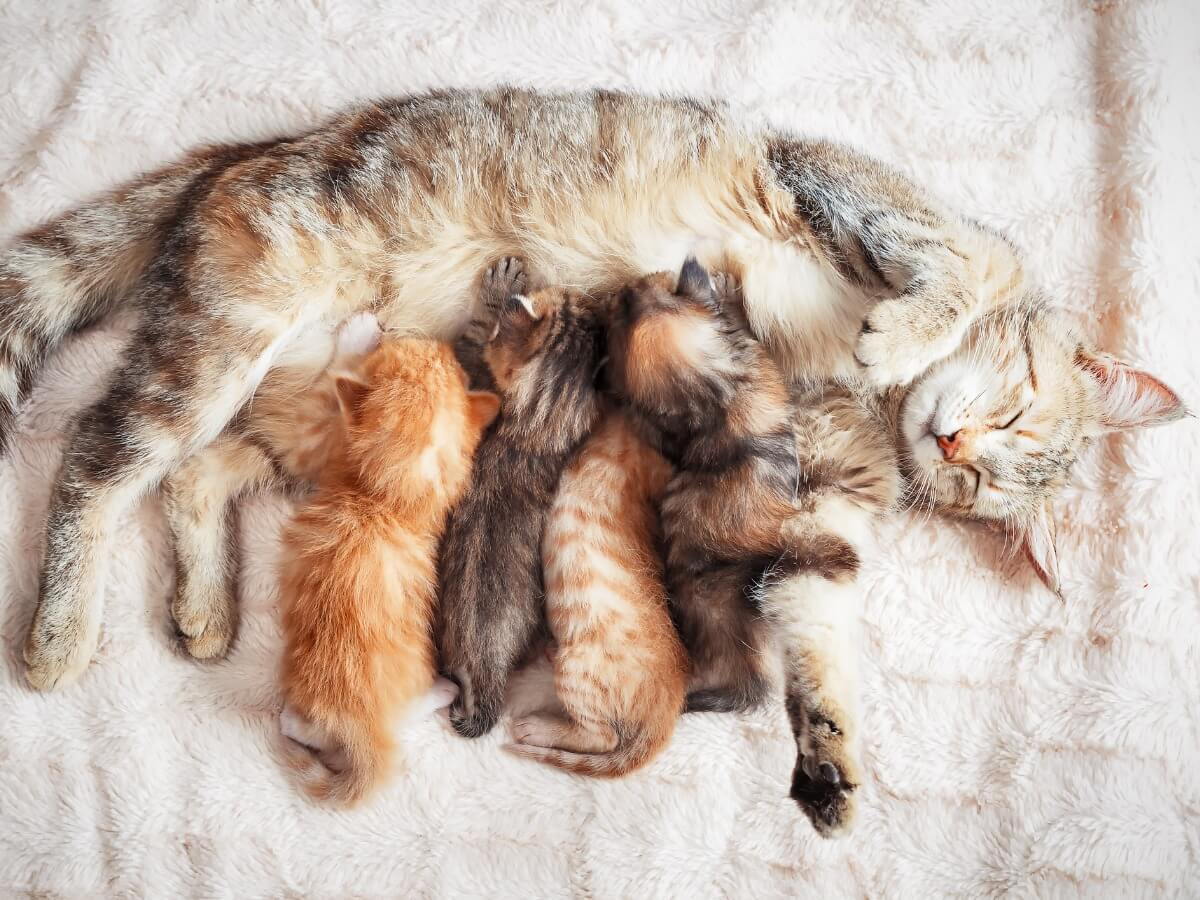Dystocia in Cats: Causes, Symptoms, and Treatment


Written and verified by the biologist Cesar Paul Gonzalez Gonzalez
Gestation in cats usually ends with a birth without any complications, and the kittens are born safely and quite healthy. Despite this, in some cases, there may be difficulties in giving birth, such as dystocia in cats, which endangers the life of the cat and her kittens.
Dystocia is one of the rarest problems in the delivery of cats, but it’s very important to be aware of some warning signs that may show that the cat is suffering from this condition. In the following article, we’ll look at the most frequent signs and causes of this condition, but you should always go to the vet in the event of any emergency (however slight it may seem).
Birth in cats: stage by stage
Cats have a gestation period that lasts from 56 to 70 days and they give birth to a litter of between 1 and 5 kittens. Before birth, the fetuses begin to position themselves correctly to facilitate their exit. In addition, the cats have a change of behavior in the week before birth, as they try to prepare for the birth as much as they can.
The birth is divided into 3 different stages, which are differentiated by the cat’s behavior and some physical signs. These are as follows:
- Stage 1 (2-24 hours duration): Contractions begin in the womb and uterus, and the cat will be restless, panting, and may even vomit. She usually purrs quite loudly and a clear fluid will start to come out of her genital region.
- Stage 2 (2-12 hours long): This is the moment the fetuses are expelled from the mother and it lasts an average of 12 hours. Normally there’s a difference of 30 to 60 minutes between each kitten coming out, although sometimes they can be born within a few minutes of each other.
- Stage 3 (occurs at the same time as stage 2): The fetal membrane, which is the “bag” that held the kittens inside the mother, is expelled. This stage usually alternates with the second stage, although not necessarily at the same time, as sometimes more than one kitten will come out before the first fetal membrane comes into sight.

What is dystocia in cats?
Dystocia is the name given to births in which the mother finds it difficult to expel their offspring. This problem becomes evident in stage 2 of the birth, because here the first kitten will take more than 60 minutes to come out. If this happens, don’t hesitate to call your vet, as it’s very likely that your cat will need emergency care.
Although this problem is usually detected at the time of delivery, prenatal tests for the cat can identify whether or not she may have dystocia. Thanks to this, the veterinarian will be able to monitor the pregnancy, which will reduce the risk of complications.
Causes of dystocia in cats
Dystocias are classified according to the factors that cause the complication, which can come from the mother or the fetus. Both types of dystocia have their differences, so they must be treated specifically. Some of their characteristics are listed below:
- Maternal dystocia: This obstruction is caused by the mother, who usually has a narrow pelvic canal or poorly developed uterine inertia. The first situation is where the pelvis isn’t the right size (with malformation, fractures, or immaturity), and the kittens won’t be able to exit correctly. The second is where there’s an absence of contractions in the uterus, which makes it impossible to expel the fetuses.
- Fetal dystocia: The fetuses can obstruct the exit and cause complications in the delivery if they have malformations, are too big, or are in an inadequate exit position.
Predisposition to dystocia
Although dystocia is a rare complication, some breeds, such as brachycephalic breeds (Persian, Himalayan, Munchkin, or Scottish Fold) have an incidence of as much as 10%. This is usually to do with the genetic makeup of certain types of cats, as inbreeding increases the number of malformations in the mother and fetuses.
Also, cats that are too old or too young tend to have dystocia more often, because their bodies aren’t prepared for childbirth. Be careful with your pet’s reproductive age when carrying out breeding, and always put her health first.
And, if that weren’t enough, it’s also important to take into account the father of the kittens, because the difference in size between them could result in larger fetuses in the mother’s uterus. This would mean that the cat won’t be able to give birth under normal conditions, and would require emergency care.
Warning signs of feline dystocia
Dystocia is a problem that can’t usually be identified until the time of delivery, as it isn’t a standard procedure for the pet to have a prenatal check-up. For this reason, there are some warning signs that you should take into account if your cat is going to give birth very soon. We recommend that you go to the vet if you notice any of the following symptoms:
- More than an hour has passed since the onset of contractions, but the first kitten hasn’t yet come out.
- The cat is vocalizing quite loudly with obvious signs of pain.
- Your pet has been pregnant for 70 days or more before going into labor.
- You can see part of the first fetus, but it hasn’t been expelled (don’t try to take it out on your own, you could harm the kitten or the mother).
- The cat looks tired, droopy, and has vomited a lot.
- The presence of foul-smelling vaginal secretions.
These warning signs can be difficult to recognize during labor. For this reason, it’s recommended to go for a prenatal check-up with a vet, as this way you can monitor the risks before the birth takes place.
Treatment of dystocia
Because dystocia is caused by different factors, there are also several ways to treat it. To do this, the veterinarian has to make a diagnosis and identify what the problem has been. Depending on what the vet observes, he or she will probably suggest one of three treatments:
- Medical treatment: If the dystocia is due to the absence of contractions, it’s possible to induce them with the use of medication. This is usually a good option when the problem is detected before delivery, thus planning the medical process.
- Manipulative treatment: If the fetuses are positioned incorrectly, the veterinarian can try to correct their position to facilitate delivery. In other words, he will help the cat to give birth by moving, or manually removing, the kitten.
- Surgical treatment: This intervention refers to a Caesarean section, in which an operation is performed to remove the kittens from the mother’s womb. This is usually the best option in emergency cases when there’s no time for diagnosis or the mother’s life is in imminent danger.

Prognosis
If the dystocia is treated in time, the cat and the kittens have a good chance of survival. However, it should be kept in mind that sometimes fetuses can die due to delivery conditions. To avoid a fatal outcome it’s best to prevent the situation from occurring and go to the vet, as this will ensure that the mother and kittens survive together.
Gestation in cats usually ends with a birth without any complications, and the kittens are born safely and quite healthy. Despite this, in some cases, there may be difficulties in giving birth, such as dystocia in cats, which endangers the life of the cat and her kittens.
Dystocia is one of the rarest problems in the delivery of cats, but it’s very important to be aware of some warning signs that may show that the cat is suffering from this condition. In the following article, we’ll look at the most frequent signs and causes of this condition, but you should always go to the vet in the event of any emergency (however slight it may seem).
Birth in cats: stage by stage
Cats have a gestation period that lasts from 56 to 70 days and they give birth to a litter of between 1 and 5 kittens. Before birth, the fetuses begin to position themselves correctly to facilitate their exit. In addition, the cats have a change of behavior in the week before birth, as they try to prepare for the birth as much as they can.
The birth is divided into 3 different stages, which are differentiated by the cat’s behavior and some physical signs. These are as follows:
- Stage 1 (2-24 hours duration): Contractions begin in the womb and uterus, and the cat will be restless, panting, and may even vomit. She usually purrs quite loudly and a clear fluid will start to come out of her genital region.
- Stage 2 (2-12 hours long): This is the moment the fetuses are expelled from the mother and it lasts an average of 12 hours. Normally there’s a difference of 30 to 60 minutes between each kitten coming out, although sometimes they can be born within a few minutes of each other.
- Stage 3 (occurs at the same time as stage 2): The fetal membrane, which is the “bag” that held the kittens inside the mother, is expelled. This stage usually alternates with the second stage, although not necessarily at the same time, as sometimes more than one kitten will come out before the first fetal membrane comes into sight.

What is dystocia in cats?
Dystocia is the name given to births in which the mother finds it difficult to expel their offspring. This problem becomes evident in stage 2 of the birth, because here the first kitten will take more than 60 minutes to come out. If this happens, don’t hesitate to call your vet, as it’s very likely that your cat will need emergency care.
Although this problem is usually detected at the time of delivery, prenatal tests for the cat can identify whether or not she may have dystocia. Thanks to this, the veterinarian will be able to monitor the pregnancy, which will reduce the risk of complications.
Causes of dystocia in cats
Dystocias are classified according to the factors that cause the complication, which can come from the mother or the fetus. Both types of dystocia have their differences, so they must be treated specifically. Some of their characteristics are listed below:
- Maternal dystocia: This obstruction is caused by the mother, who usually has a narrow pelvic canal or poorly developed uterine inertia. The first situation is where the pelvis isn’t the right size (with malformation, fractures, or immaturity), and the kittens won’t be able to exit correctly. The second is where there’s an absence of contractions in the uterus, which makes it impossible to expel the fetuses.
- Fetal dystocia: The fetuses can obstruct the exit and cause complications in the delivery if they have malformations, are too big, or are in an inadequate exit position.
Predisposition to dystocia
Although dystocia is a rare complication, some breeds, such as brachycephalic breeds (Persian, Himalayan, Munchkin, or Scottish Fold) have an incidence of as much as 10%. This is usually to do with the genetic makeup of certain types of cats, as inbreeding increases the number of malformations in the mother and fetuses.
Also, cats that are too old or too young tend to have dystocia more often, because their bodies aren’t prepared for childbirth. Be careful with your pet’s reproductive age when carrying out breeding, and always put her health first.
And, if that weren’t enough, it’s also important to take into account the father of the kittens, because the difference in size between them could result in larger fetuses in the mother’s uterus. This would mean that the cat won’t be able to give birth under normal conditions, and would require emergency care.
Warning signs of feline dystocia
Dystocia is a problem that can’t usually be identified until the time of delivery, as it isn’t a standard procedure for the pet to have a prenatal check-up. For this reason, there are some warning signs that you should take into account if your cat is going to give birth very soon. We recommend that you go to the vet if you notice any of the following symptoms:
- More than an hour has passed since the onset of contractions, but the first kitten hasn’t yet come out.
- The cat is vocalizing quite loudly with obvious signs of pain.
- Your pet has been pregnant for 70 days or more before going into labor.
- You can see part of the first fetus, but it hasn’t been expelled (don’t try to take it out on your own, you could harm the kitten or the mother).
- The cat looks tired, droopy, and has vomited a lot.
- The presence of foul-smelling vaginal secretions.
These warning signs can be difficult to recognize during labor. For this reason, it’s recommended to go for a prenatal check-up with a vet, as this way you can monitor the risks before the birth takes place.
Treatment of dystocia
Because dystocia is caused by different factors, there are also several ways to treat it. To do this, the veterinarian has to make a diagnosis and identify what the problem has been. Depending on what the vet observes, he or she will probably suggest one of three treatments:
- Medical treatment: If the dystocia is due to the absence of contractions, it’s possible to induce them with the use of medication. This is usually a good option when the problem is detected before delivery, thus planning the medical process.
- Manipulative treatment: If the fetuses are positioned incorrectly, the veterinarian can try to correct their position to facilitate delivery. In other words, he will help the cat to give birth by moving, or manually removing, the kitten.
- Surgical treatment: This intervention refers to a Caesarean section, in which an operation is performed to remove the kittens from the mother’s womb. This is usually the best option in emergency cases when there’s no time for diagnosis or the mother’s life is in imminent danger.

Prognosis
If the dystocia is treated in time, the cat and the kittens have a good chance of survival. However, it should be kept in mind that sometimes fetuses can die due to delivery conditions. To avoid a fatal outcome it’s best to prevent the situation from occurring and go to the vet, as this will ensure that the mother and kittens survive together.
All cited sources were thoroughly reviewed by our team to ensure their quality, reliability, currency, and validity. The bibliography of this article was considered reliable and of academic or scientific accuracy.
- Conde, B. U. Reproducción felina. Enfermedades relacionadas con la reproducción. Jornada para Criadores Felinos.
- Ekstrand, C., & Linde‐Forsberg, C. (1994). Dystocia in the cat: a retrospective study of 155 cases. Journal of Small Animal Practice, 35(9), 459-464.
- García Mitacek, M. C. (2013). Efecto de cloprostenol y aglepristone sobre la gestación temprana y media en felinos (Doctoral dissertation, Universidad Nacional de La Plata).
- de Tejerina, J. C. D. F., Vega, F. J. P., & Llamazares, B. C. (1994). Parto y distocias en la perra y en la gata. Clínica veterinaria de pequeños animales: revista oficial de AVEPA, Asociación Veterinaria Española de Especialistas en Pequeños Animales, 14(4), 223-241.
- Sanchez, A. E., & Silva, M. E. (2002). Biología de la gestación en la gata doméstica (Felis catus). Archivos de medicina veterinaria, 34(2), 147-156.
- Angulo, S. M. (2016). La cesárea en la perra y la gata. Argos: Informativo Veterinario, (177), 86-90.
This text is provided for informational purposes only and does not replace consultation with a professional. If in doubt, consult your specialist.








